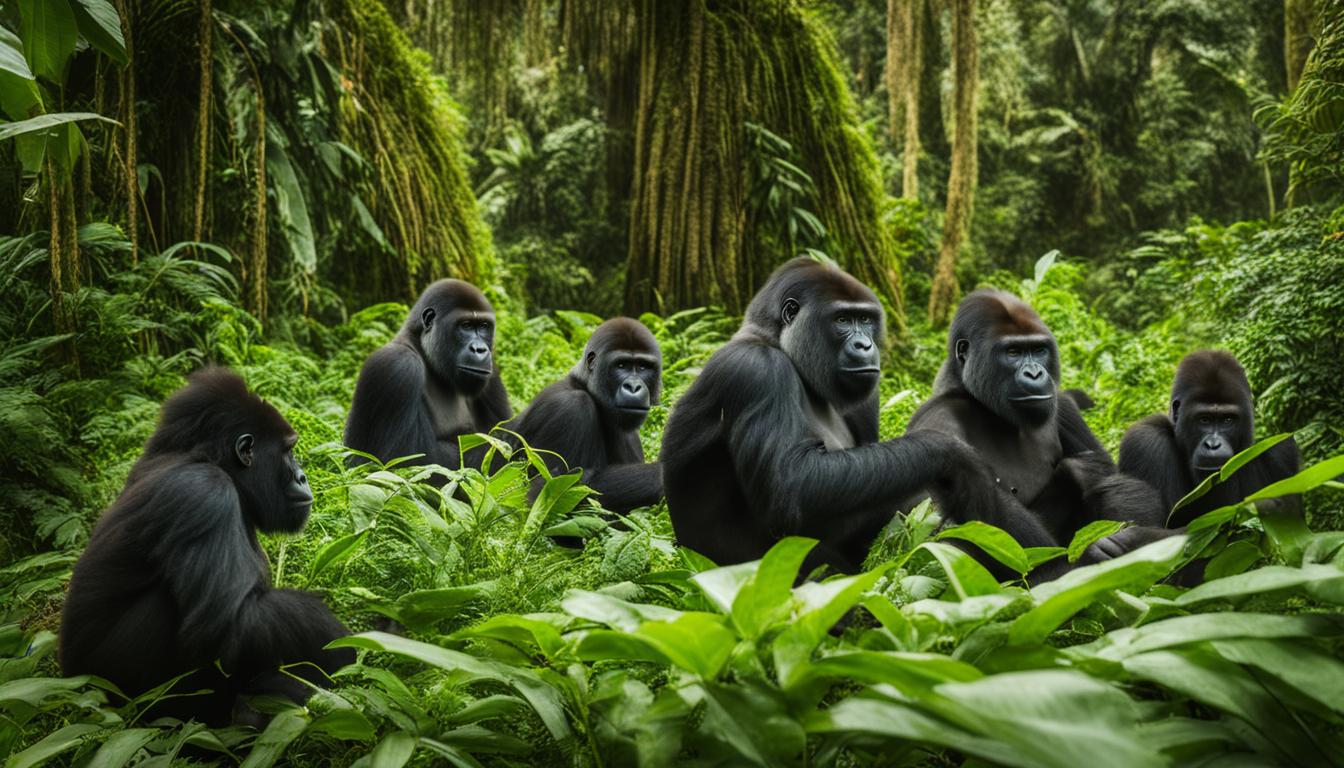Gorillas are herbivorous great apes that inhabit the tropical forests of equatorial Africa. They are divided into two species: the eastern gorilla and the western gorilla. Gorillas live in troops, with the leader being called a silverback. The natural habitats of gorillas cover tropical or subtropical forests in Sub-Saharan Africa, at a wide range of elevations.
The mountain gorilla inhabits the Virunga Volcanoes in the Albertine Rift montane cloud forests, while lowland gorillas live in dense forests and swamps as low as sea level. The western gorilla population is estimated to be around 316,000, while the eastern gorilla population is around 5,000. Gorillas are classified as Critically Endangered due to threats such as poaching and habitat destruction. It is essential to protect their habitats to ensure the survival of these incredible creatures.
Gorilla Behavior and Diet
Gorillas are fascinating creatures that exhibit unique behaviors and have specific dietary needs. Understanding their behavior and diet is key to conserving their natural habitats and ensuring their survival.
Behavior:
Gorillas live in stable family groups called troops, which are led by a dominant male known as the silverback. These troops have complex social structures, and gorillas form strong bonds within their groups. They communicate through a combination of vocalizations, body language, and facial expressions. Gorillas are primarily ground-dwelling creatures, but they are capable of climbing trees when necessary. They spend a significant amount of time foraging for food, socializing, and grooming each other.
Diet:
Gorillas are herbivores with a primarily vegetarian diet. They consume a variety of vegetation, including stems, shoots, fruits, leaves, and bark. They also eat flowers and invertebrates. Gorillas have a large digestive system that allows them to efficiently process fibrous plant material. Their diet varies depending on the availability of food in their natural habitat. The resources provided by their habitats, such as a wide range of plant species, are essential for their survival.
“There is something truly captivating about observing gorillas in their natural habitat. Their behaviors and interactions provide valuable insights into their social structures and the way they navigate their environments.” – Wildlife conservationist
Gorilla Diet in Different Habitats
Gorilla diets can vary depending on their specific habitat. Here is a comparison of the diets of the two gorilla species and their respective habitats:
| Gorilla Species | Habitat | Diet |
|---|---|---|
| Mountain Gorillas | Virunga Volcanoes in the Albertine Rift montane cloud forests | Primarily eat foliage from bamboo, wild celery, and other plants found in the mountains. They also consume tree bark and invertebrates. |
| Lowland Gorillas | Dense forests and swamps in Sub-Saharan Africa | Consume a wide variety of plant species, including fruits, leaves, stems, and shoots. They also eat tree bark and invertebrates. |
Understanding the behavior and diet of gorillas is crucial for their conservation. By protecting their habitats and ensuring the availability of the necessary resources, we can help these magnificent creatures thrive in the wild.
Gorilla Conservation and Population
Gorillas, one of the most iconic species on our planet, are facing significant challenges when it comes to conservation. The International Union for Conservation of Nature (IUCN) classifies gorillas as Critically Endangered. This classification is due to the various threats they face, including poaching, habitat destruction, and disease. Without proper conservation efforts, these magnificent creatures could face extinction.
To protect gorillas and their habitats, conservation initiatives are being implemented. These initiatives aim to preserve and restore gorilla habitat, reduce poaching activities, and increase awareness about the importance of gorilla conservation. By conserving gorilla habitats, we not only ensure the survival of these incredible animals but also contribute to the preservation of the entire ecosystem they inhabit.
The population of gorillas is a critical factor in their conservation. Currently, the estimated population of western gorillas is around 316,000, while the population of eastern gorillas is only around 5,000. These numbers highlight the urgent need for conservation efforts to focus on protecting and increasing gorilla populations. Through careful monitoring, research, and protection, we can work towards stabilizing and expanding gorilla populations for future generations.
Table: Population Estimates of Gorilla Species
| Gorilla Species | Population Estimate |
|---|---|
| Western Gorilla | Approximately 316,000 |
| Eastern Gorilla | Approximately 5,000 |
Conservation efforts have shown some success in certain areas, but it is crucial to continue protecting gorillas and their habitats. Collaborative efforts involving local communities, governments, non-profit organizations, and international conservation agencies are essential for the long-term sustainability of gorilla populations.
By supporting and engaging in gorilla conservation initiatives, we can make a significant impact on the preservation of these majestic creatures and the ecosystems they rely on. Together, we can ensure a future where gorillas thrive and continue to inspire awe and wonder.
Gorilla Habitats Around the World
Gorillas inhabit various countries in Africa, each offering a unique and diverse habitat for these magnificent creatures. Let’s explore some of the countries where gorillas can be found:
- Central West African countries: This is the home of the western lowland gorilla, including countries such as Cameroon, Equatorial Guinea, and Gabon. These gorillas live in dense forests and swamps, adapting to their natural habitat.
- Democratic Republic of the Congo: The eastern lowland gorilla can be found in the dense forests of the Democratic Republic of the Congo. These gorillas have adapted to survive in this challenging environment.
- Virunga Volcanoes, Albertine Rift: The mountain gorilla inhabits the montane cloud forests of the Virunga Volcanoes. These gorillas live at high elevations and have adapted to the challenging conditions of this unique habitat.
- Other countries: Gorillas can also be found in Angola, Rwanda, Uganda, and the Central African Republic. Each of these countries provides different habitats, from dense forests to mountainous regions.
These diverse gorilla habitats are vital for their survival, providing the necessary resources for their diet and behavior. It is crucial to protect these habitats and ensure the conservation of gorilla populations.
Gorilla Habitats Around the World

| Country | Gorilla Species | Natural Habitat |
|---|---|---|
| Central West African countries | Western Lowland Gorilla | Dense forests, swamps |
| Democratic Republic of the Congo | Eastern Lowland Gorilla | Dense forests |
| Virunga Volcanoes, Albertine Rift | Mountain Gorilla | Montane cloud forests |
| Angola | Western Lowland Gorilla | Dense forests |
| Rwanda | Mountain Gorilla | Dense forests, mountainous regions |
| Uganda | Mountain Gorilla, Eastern Lowland Gorilla | Dense forests, mountainous regions, swamps |
| Central African Republic | Western Lowland Gorilla | Dense forests |
Conclusion
Gorillas are majestic creatures that inhabit the tropical forests of equatorial Africa. Their natural habitats provide the necessary resources for their diet and behavior. However, gorillas are facing threats such as poaching and habitat destruction, which pose a risk to their population.
Conservation efforts are ongoing to protect their habitats and increase their numbers. It is crucial to raise awareness and support initiatives that aim to preserve gorilla habitats and ensure the survival of these incredible creatures.
By protecting gorilla habitats, we can help secure a future for these magnificent animals.
How does the location of gorillas in the wild impact their lifespan?
The average lifespan of gorillas in the wild is greatly influenced by their location. Those living in protected areas tend to have longer lifespans due to reduced human threats and access to food sources. In contrast, gorillas in areas with high levels of hunting and deforestation may have significantly shorter lifespans.
FAQ
Where can gorillas be found in the wild?
Gorillas can be found in various countries in Africa, including Central West African countries, the Democratic Republic of the Congo, Angola, Cameroon, Equatorial Guinea, Gabon, Rwanda, Uganda, and the Central African Republic. They inhabit tropical or subtropical forests in Sub-Saharan Africa at a wide range of elevations.
What is the behavior and diet of gorillas?
Gorillas are predominantly ground-dwelling creatures that live in stable family groups. They exhibit complex social structures and form strong bonds within their troops. The dominant male, known as the silverback, leads the group. Gorillas spend a significant amount of time feeding on vegetation, including stems, shoots, fruits, leaves, bark, flowers, and invertebrates.
Why are gorillas facing conservation challenges?
Gorillas are facing significant challenges in terms of conservation due to threats such as poaching, habitat destruction, and disease. As a result, they are classified as Critically Endangered by the IUCN. Efforts are being made to protect gorilla habitats and increase their population through conservation initiatives.
How many gorillas are there in the world?
The western gorilla population is estimated to be around 316,000, while the eastern gorilla population is around 5,000. However, both species are classified as Critically Endangered, highlighting the need for ongoing conservation efforts to ensure their survival.
What are some gorilla habitats around the world?
Gorillas can be found in a variety of habitats, including dense forests, swamps, and montane cloud forests. The western lowland gorilla is found in Central West African countries, while the eastern lowland gorilla is found in the Democratic Republic of the Congo. Mountain gorillas inhabit the Virunga Volcanoes in the Albertine Rift montane cloud forests.







